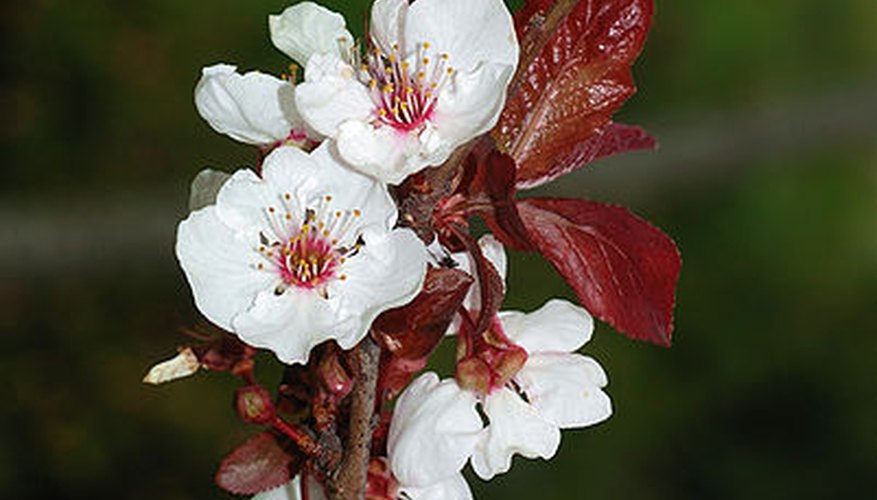Purple leaf plum (Prunus cerasifera) is a short-lived ornamental that can reach 25 feet in its 20-year lifespan. Rapid growth and dramatic purple leaves when planted in full sun make this tree a landscaping favourite. Purple leaf plum blooms with small white or pale pink flowers in early spring before leaves unfold and will bear small edible fruits in July. Purple leaf plums need a well-drained soil to thrive.
History
In 1878, Monsieur Pissard, a French gardener working for the shah of Persia (now Iran), encountered a purple leaf mutation on one branch of a plum tree in the city of Tabriz, in the Caucasus desert mountains not far from the Armenian border. Pissard made a cutting, propagated trees and forwarded specimens to his associate, Monsieur Chatenay in France. Chatenay introduced the purple leaf plum to European landscapes during the next few years.
Propagation
Purple leaf plum can grow from seed and now grows wild in New Zealand where its seeds spread from gardens. However, it is best propagated from leafless hardwood cuttings of the current year's growth during late autumn through late winter, when the tree is dormant and tissues are mature. In commercial nurseries, cuttings are taken from permanent hedges severely cut back each winter to maintain vigour. The hardwood should be exposed to a growth hormone and then planted in a sterile sandy medium that is kept warm. Fungicides applied along with the growth hormone improve success rate.
- Purple leaf plum can grow from seed and now grows wild in New Zealand where its seeds spread from gardens.
- In commercial nurseries, cuttings are taken from permanent hedges severely cut back each winter to maintain vigour.
Pruning
Pruning is not really necessary, because purple leaf plum trees form a compact round canopy. If the landscape design calls for a crown lower than 20 feet, selective pruning will control height. To avoid cleaning up fallen fruit, prune after the spring bloom. If the dense display of flowers is unimportant in the landscape design, a light pruning of the buds in late winter will avoid fruit altogether. Several hybrids can be planted as hedges, set 4 feet apart and pruned to encourage bushy growth.
- Pruning is not really necessary, because purple leaf plum trees form a compact round canopy.
- If the landscape design calls for a crown lower than 20 feet, selective pruning will control height.
Cultivars
The most frequently planted purple leaf plum in U.S. landscapes is Thunderbird, which has pink flowers and cherry size fruits. Atropurpurea is closer to Pissard's original discovery. Atropurpurea blooms white and its leaves emerge red in spring and change to purple with the season. Krauter Vesuvius grows to only 15 feet, with light pink flowers and leaves that are dark purple to almost black. Nigra grows less than 18 inches per year and can be maintained at 4 to 6 feet as a hedge, although it can reach 25 feet.
- The most frequently planted purple leaf plum in U.S. landscapes is Thunderbird, which has pink flowers and cherry size fruits.
- Atropurpurea blooms white and its leaves emerge red in spring and change to purple with the season.
Virus
Plums are members of the Rosacea (rose) family of shrubs and trees, many of which bear edible produce, including plum, cherry, apricot, peach and almond. Purple leaf plums are susceptible to viruses that also infect commercial crops. A study in Turkey found that purple leaf plum in urban landscapes is a reservoir for several fruit tree viruses, including plum pox virus (PPV), which originated in Bulgaria in the early 1900s and entered the United States in the 1990s. PPV spreads regionally in rootstock and seedlings, and is carried locally by aphids. PPV lowers total yield and reduces marketable yield by deforming fruits.
- Plums are members of the Rosacea (rose) family of shrubs and trees, many of which bear edible produce, including plum, cherry, apricot, peach and almond.
- A study in Turkey found that purple leaf plum in urban landscapes is a reservoir for several fruit tree viruses, including plum pox virus (PPV), which originated in Bulgaria in the early 1900s and entered the United States in the 1990s.
